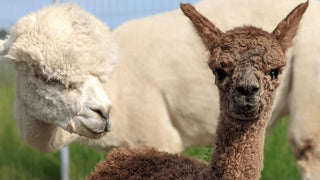Venturing into the world of alpaca farming for the purposes of fibre and yarn production, especially for those of us without a whit of farming experience, is akin to stepping into a new world brimming with potential yet fraught with challenges.
The Allure of Alpacas
The allure of alpaca farming isn't just in the enchanting, gentle nature of these creatures or their eco-friendly appeal; it's also in the growing market for high-quality alpaca fibre, a luxury commodity in the textile industry.
However, this isn't a journey to embark upon lightly. It requires a blend of passion, patience, and practicality. Let's dive deep into the nuances of starting an alpaca farm from scratch, focusing on herd size, assessing animal and fibre quality, building a market for your alpaca fibre, and understanding the social and ecological contributions of this endeavour.

Learn about Farming Alpacas for Fibre Production
- Alpaca fibre is soft, hypoallergenic, and sustainable. It makes incredible yarn.
- Alpacas are gentle, relatively easy to care for, and can be profitable for fibre production.
- Proper care, nutrition, and annual shearing are essential in farming alpacas for fibre production.
Understanding Alpaca Farming
Alpaca farming, at its core, is about sustainable livestock management and fibre production. Alpacas, native to the Andean mountain ranges of South America, have been bred for thousands of years for their exquisite fibre. Unlike sheep's wool, alpaca fibre is lanolin-free, making it hypoallergenic, and it's renowned for its softness, strength, and thermal properties.

Starting with the Right Herd Size
For novices, the question of herd size is paramount. Starting small is not merely advice; it's a doctrine. A manageable herd for a beginner is between three to eight animals. This size is large enough to ensure alpacas' social well-being (alpacas are herd animals and suffer from isolation) and small enough to allow new farmers to learn alpaca care, behavior, and fibre management without becoming overwhelmed. Of course, if you’re like me, you start big and jump right in. A slower, more strategic approach would have allowed me to learn more things the easy way. But that’s a story for another day.
Insider Tip: “When starting, prioritize quality over quantity. A few high-quality alpacas will serve your farm better in the long run than a larger herd of lesser quality.”
Assessing Animal and Fibre Quality
The heart of alpaca farming for fibre production lies in the quality of both the animals and the fibre or fleece that they produce. When assessing alpacas, consider:
- Genetics: Research the lineage for traits like fibre density, fineness, and uniformity.
- Health: Healthy alpacas are alert, active, and have bright, clear eyes. A vet check can confirm good health status.
- Fibre Quality: Fibre is graded from ultra-fine to robust, based on micron count (the diameter of the fibre). Generally speaking, the lower the micron count, the finer and more valuable the fibre.
Insider Tip: “Invest in histograms. It’s a special test that measures the actual diameter of the individual fibres of any given fleece. Knowing the exact quality of your alpacas’ fibre can significantly impact your pricing and marketing strategy.” Learn more.

Histogram and sample of Authentic's first fleece.
Building a Market for Alpaca Fibre
The market for alpaca fibre is niche but growing. Luxury fashion brands, eco-conscious consumers, and the handcrafting community (knitters, weavers) are key markets. Building a market presence starts with understanding your product's unique selling points—sustainability, quality, and the story of your farm—and leveraging them through:
- Online Platforms: Utilize social media, your farm’s website, and online marketplaces tailored to handmade and eco-friendly goods.
- Local Artisans and Craft Fairs: Partner with local artisans who can transform your fibre into finished goods and showcase your product at craft fairs and farmers' markets.
- Educational Workshops: Hosting workshops on your farm about alpaca care, fibre processing, and crafting can build a community of enthusiasts around your brand. Check out our alpaca events and experiences.
Insider Tip: “Never underestimate the power of storytelling. Your journey into alpaca farming and the individual stories of your alpacas can be a huge selling point.”
Personal Experience: Overcoming Challenges in Alpaca Farming

Be prepared for hard days. Farming anything is never easy and you’re going to make mistakes along the way. That’s ok; learn those lessons and move forward.
When I first started my alpaca farm, I faced numerous challenges that tested my resilience and determination. One particular hurdle I encountered early on was unexpected weight loss in a number of my animals. It was only when I reached out to my mentor, and we walked through potential causes that I learned the importance of hay quality, how to assess it, and its vital role in animal health and optimal fleece production.
The Social and Eco-Friendly Nature of Alpaca Farming
Alpaca farming is more than a business; it’s a lifestyle choice that aligns with eco-friendly and socially responsible values. Alpacas are gentle on the land; their soft, padded feet minimize soil compaction, and they graze without destroying root systems. Additionally, alpaca manure is an excellent, nutrient-rich natural fertilizer.
On the social front, alpaca farming can foster community connections. Whether it's through educational initiatives, partnerships with local artisans, or participation in local farmers' markets, alpaca farms often become integral parts of their local ecosystems, promoting sustainable agriculture and artisanal craftsmanship.
Alpaca farming also represents a stand against fast fashion. By producing a sustainable, high-quality fibre that supports slow fashion and ethical consumerism, alpaca farmers contribute to a more sustainable and equitable world.

Image courtesy of www.goldentouchnaturals.us via Google Images
Conclusion
Embarking on an alpaca farming venture is no small feat, especially for those of us stepping into farming for the first time. It requires a significant investment of time, resources, and heart. However, the rewards—both tangible and intangible—are immense. Not only does alpaca farming offer the potential for financial gain through the production of luxury fibre, but it also allows individuals to live in harmony with nature, contribute to the sustainability of the planet, and engage in meaningful social enterprises.
As we've explored, starting with a manageable herd size, focusing on animal and fibre quality, strategically building a market for your product, and embracing the eco-friendly and social aspects of alpaca farming are critical steps to success. It's a journey of continuous learning and adaptation, but for those who are passionate about sustainable agriculture and crafting a lifestyle in tune with their values, alpaca farming can be an incredibly rewarding endeavour. But before you jump right in, there are a few other things to consider before you bring your alpacas home
Remember, the key to successful alpaca farming is not just in mastering the technical aspects but in weaving the love for these animals and the environment into the very fabric of your farm's story.
Question & answers
How profitable is farming alpacas for fibre production?
The demand for luxurious alpaca fibre products is growing. Profitability - in any business - is dependant on a number of factors. Demand is just one.
What if I don't have any farming experience?
Alpacas are relatively easy animal to farm. You can start small and learn from resources. Established and experienced alpaca farmers are a great source of advise and guidance.
How can I ensure the quality of my alpacas and their fibre?
Start with high quality animals of known pedigree from established alpaca farms. Provide your alpacas with proper nutrition, annual shearing, and regular health assessments.

